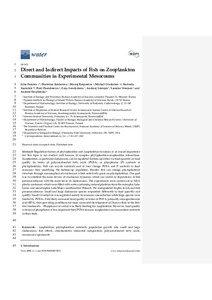Direct and indirect impacts of fish on crustacean zooplankton in experimental mesocosms
Скачать файл:
DOI:
10.3390/w11102090Автор:
Feniova, I.
Sakharova, E.
Karpowicz, M.
Gladyshev, M. I.
Sushchik, N. N.
Dawidowicz, P.
Gorelysheva, Z.
Górniak, A.
Stroinov, Y.
Dzialowski, A.
Коллективный автор:
Институт фундаментальной биологии и биотехнологии
Кафедра водных и наземных экосистем
Дата:
2019-10Журнал:
Water (Switzerland)Квартиль журнала в Scopus:
Q1Квартиль журнала в Web of Science:
Q2Библиографическое описание:
Feniova, I. Direct and indirect impacts of fish on crustacean zooplankton in experimental mesocosms [Текст] / I. Feniova, E. Sakharova, M. Karpowicz, M. I. Gladyshev, N. N. Sushchik, P. Dawidowicz, Z. Gorelysheva, A. Górniak, Y. Stroinov, A. Dzialowski // Water (Switzerland). — 2019. — Т. 11 (№ 10). — С. 2090Аннотация:
Understanding the factors that regulate phytoplankton and zooplankton is an important goal of aquatic ecologists; however, much remains unknown because of complex interactions between phytoplankton, zooplankton, and fish. Zooplankton, in particular cladocerans, can be regulated by bottom–up factors either via food quantity or food quality in terms of polyunsaturated fatty acids (PUFA) or phosphorus (P) contents in phytoplankton. Fish can recycle nutrients and in turn change the PUFA and P contents of algal resources, thus modifying bottom–up regulation. Furthermore, fish can change phytoplankton structure through consumption of cladocerans which selectively graze phytoplankton. We conducted a mesocosm (300 L) experiment to determine how trophic state and fish affected crustacean dynamics. The mesocosms were filled with water containing natural plankton from the eutrophic Lake Jorzec and mesotrophic Lake Majcz (Northeastern Poland), and we manipulated fish presence/absence. We also conducted a complementary life-table experiment to determine how trophic state and fish nonconsumptively affected demographic parameters of the dominant cladocerans in the mesocosms. Small and large cladoceran species responded differently to food quantity and quality. Small-bodied Ceriodaphnia were regulated mainly by resource concentrations (i.e., food quantity), while large species were limited by PUFAs (i.e., food quality). Fish likely increased food quality in terms of PUFA, primarily eicosapentaenoic acids (EPA), thus providing conditions for more successful development of Daphnia than in the fish-free treatments. Phosphorus in the seston was likely limiting for zooplankton. However, food quality in terms of phosphorus was likely less important than PUFA because zooplankton can accumulate nutrients in their body.

